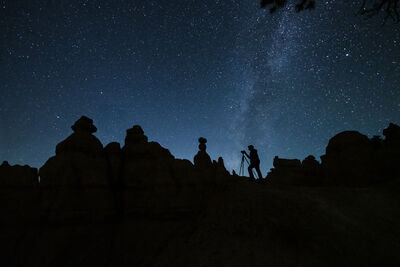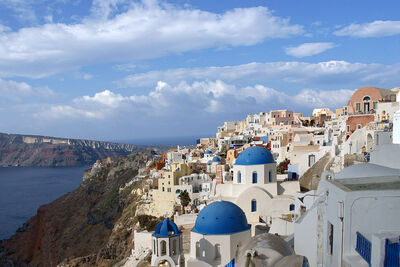8 Bit tiff vs 16 Bit tiff
May 2, 2015 21:26:52 #
I have a choice when I export from DXO to my catalog file, 16 bit tiff, 8 bit tiff, 8 bit tiff compressed & JPEG.
I've tried them all and to my eye I see no difference, I do see a difference in the file size from 8 bit vs JPEG. I'm not interested in saving as a JPEG, however my question is will I be able to see a difference between the different tiff formats that I have options for? Thanks in advance for your advise.
I've tried them all and to my eye I see no difference, I do see a difference in the file size from 8 bit vs JPEG. I'm not interested in saving as a JPEG, however my question is will I be able to see a difference between the different tiff formats that I have options for? Thanks in advance for your advise.
May 2, 2015 21:48:09 #
Yes, they do look the same. However, if you plan to do additional processing on the image, there's a greater chance of undesirable artifacts showing up with the 8 bit file, such as banding.
May 3, 2015 06:33:57 #
rook2c4 wrote:
Yes, they do look the same. However, if you plan to do additional processing on the image, there's a greater chance of undesirable artifacts showing up with the 8 bit file, such as banding.
:thumbup: :thumbup: :thumbup:
May 3, 2015 08:35:36 #
Kevin.M wrote:
I have a choice when I export from DXO to my catalog file, 16 bit tiff, 8 bit tiff, 8 bit tiff compressed & JPEG.
I've tried them all and to my eye I see no difference, I do see a difference in the file size from 8 bit vs JPEG. I'm not interested in saving as a JPEG, however my question is will I be able to see a difference between the different tiff formats that I have options for? Thanks in advance for your advise.
I've tried them all and to my eye I see no difference, I do see a difference in the file size from 8 bit vs JPEG. I'm not interested in saving as a JPEG, however my question is will I be able to see a difference between the different tiff formats that I have options for? Thanks in advance for your advise.
Yes, there is a difference, 16-bit TIFF or other files contain more information than 8-bit TIFF. JPG / JPEG files by definition are 8-bit compressed files (with data loss).
Think how computer Operating Systems and programs have advanced from 8-bit to 16-bit to 32-bit to 64-bit. Note 8 bits = 1 byte.
Personally I rarely work with tiff files, working with Ps PSD files and then converting to jpg's for WEB Publishing or Printing. But I would imagine that I could see a difference between 8 and 16 bit tif files because I can with 8 & 16 bit PSD files. The difference may be slight to your eye unless you start to edit and processes and add layers. Then first jpg, then 8-bit uncompressed image files my start to "fall apart" as to quality. If you are able to some things or tools with Ps can be used with 32-bit files (HDR for example), but the file sizes become truly massive!
I once tried making a Stitched Panorama with Photoshop CS6 with 16-bit files. That monster generated was smoking my computer nearly, an over 1.2 GB file that Ps and Windows would not let me save. Too big! I managed to scale it don't and save it with a second try from scratch.
May 3, 2015 11:44:29 #
Unless you are making very large color prints, showing photos on a large screen, or entering them in a contest, 8 bit is fine.
May 3, 2015 14:49:15 #
ralphc4176
Loc: Conyers, GA
The 16-bit tiffs will be better than the 8-bit tiffs in terms of getting the sharpest BIG enlargement, and the 16-bit tiffs may display better results if there is any post processing. If all you are looking for is 4x6, 5x7, 8x10, or 8x12 prints, you will probably never notice a difference between a 16-bit tiff and an 8-bit tiff, except that the 16-bit tiff is much larger electronically.
May 3, 2015 20:12:00 #
I always work with 16 bit files until I need a copy for web.Then I make a copy and convert the copy to 8 bit. I also print from 16 bit files.
May 3, 2015 20:44:30 #
rook2c4 wrote:
Yes, they do look the same. However, if you plan to do additional processing on the image, there's a greater chance of undesirable artifacts showing up with the 8 bit file, such as banding.
Thank you for explaining it to me.
May 3, 2015 20:45:00 #
Bob Boner wrote:
I always work with 16 bit files until I need a copy for web.Then I make a copy and convert the copy to 8 bit. I also print from 16 bit files.
Thank you for sharing the information.
May 3, 2015 20:45:43 #
rook2c4 wrote:
Yes, they do look the same. However, if you plan to do additional processing on the image, there's a greater chance of undesirable artifacts showing up with the 8 bit file, such as banding.
Thank you for the info, what is banding?
May 3, 2015 20:47:25 #
lamiaceae wrote:
Yes, there is a difference, 16-bit TIFF or other f... (show quote)
Thank you for the examples, it makes it easier to understand.
May 3, 2015 20:49:00 #
SonyA580 wrote:
Unless you are making very large color prints, showing photos on a large screen, or entering them in a contest, 8 bit is fine.
I appreciate your input, Thanks.
May 3, 2015 23:25:29 #
Kevin.M wrote:
Thank you for the info, what is banding?
Banding is a form of posterization caused by not enough range of tones. Usually shows up with heavy editing of highly compressed JPEG files. Shows up in areas of the same tonal range (skies, backdrops,,etc.).
There is also banding noise at high ISOs and is camera- dependent. Shows up in the shadows when the image is brightened.
May 20, 2015 15:31:44 #
Kevin.M wrote:
I have a choice when I export from DXO to my catalog file, 16 bit tiff, 8 bit tiff, 8 bit tiff compressed & JPEG.
I've tried them all and to my eye I see no difference, I do see a difference in the file size from 8 bit vs JPEG. I'm not interested in saving as a JPEG, however my question is will I be able to see a difference between the different tiff formats that I have options for? Thanks in advance for your advise.
I've tried them all and to my eye I see no difference, I do see a difference in the file size from 8 bit vs JPEG. I'm not interested in saving as a JPEG, however my question is will I be able to see a difference between the different tiff formats that I have options for? Thanks in advance for your advise.
Yes if you edit, especially if you edit in ProPhoto - almost zero possibility of posterization and much wider color gamut. You may not see it on your screen, especially if you are using standard gamut display on a Mac or PC. But if you have a wide gamut PC display system, there will be colors that won't be visible on the standard gamut display, that your printer or print lab can reproduce. Better to save files in 16 bit to keep all of the available options open.
If you want to reply, then register here. Registration is free and your account is created instantly, so you can post right away.




